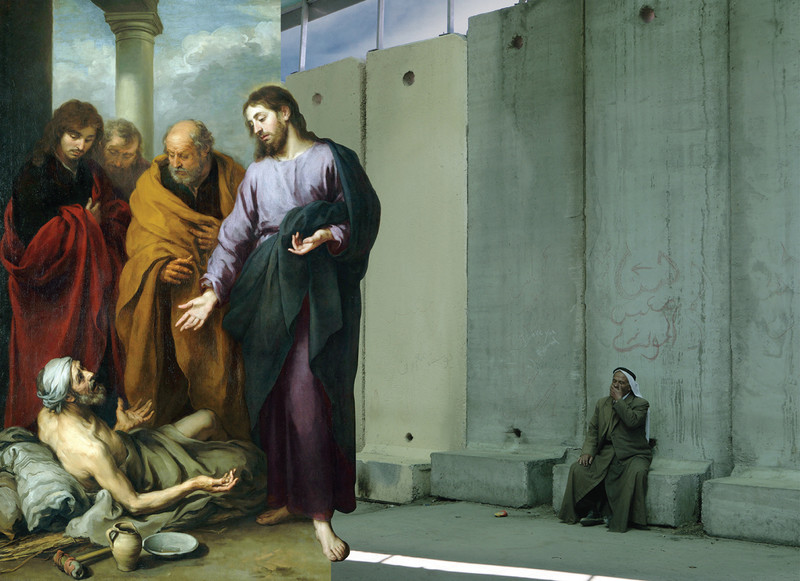Originally published on Ma’an News Agency on May 24, 2014.
BETHLEHEM (Ma’an) — In advance of Pope Francis’ visit to the Holy Land on Sunday, Bethlehem residents and officials have been busy covering the city in posters to celebrate his first official visit.
Large banners depicting His Holiness beside President Mahmoud Abbas cover major intersections, while more humble posters hang from shops and homes welcoming him on behalf of individual Bethlehem families.
In Bethlehem’s historic Manger Square, however, the Pope will be greeted by a dramatically different scene: huge renderings of classical European paintings of Biblical suffering, juxtaposed against contemporary photographs of Palestinian life.
The startling images are part of a project entitled “In the presence of the Holy See” by the Palestinian Museum to welcome the Pope in an altogether unique way by examining the Palestinian experience in relationship to one of the land’s most famous martyrs, Jesus Christ.
The banners include scenes of the lamentation of Christ beside a woman sifting through possessions after an Israeli attack on Jenin refugee camp and a man carrying away a body that is simultaneously a Palestinian killed by Israeli fire and the martyred Christ, among others.


Museum director John Persekian told Ma’an that the images are meant to help viewers, including the Pope, reframe the Palestinian issue and understand it through a more “humane” lens while also exploring the relevance of Christian teachings today.
“We were trying to take the Christian message and teachings and juxtapose them with the current situation, to help us think through what has happened over the last 66 years,” he said.
“How do we understand these experiences in relationship to messages of faith, peace, love, forgiveness, and the existence of a just God?” he added.
The banners are being hosted not only in Manger Square but also in nearby Duheisha refugee camp, home to nearly 15,000 Palestinians who fled or were expelled from their homes by Zionist militias in the 1948 war that led to the creation of the state of Israel.
In Jordan on Saturday, the pope met with Syrian refugee children, and on Sunday he plans to meet with children in Duheisha where he will see the banners.
As the Syrian conflict has driven a massive exodus from the country in recent years, the situation of Palestinian refugees — who have been denied the right of return to their homes by Israel for 66 years — looms large in the background.
“What does it mean to be humiliated for so long?” Persekian asks. “What does it tell us about faith of the dispossessed people?”
The juxtaposition of classical paintings beside black-and-white photographs creates a powerful parallel that highlights the universality of suffering even as it draws upon specific historical examples.
At the same time, Persekian says that the works hold a mirror up to the Western world and the disparate responses it has had to the suffering of the most famous Palestinian martyr Jesus and the suffering of his ancestors, the contemporary Palestinians.
“How has the world looked at and treated the Palestinians, especially the Western world where the majority is Christian? How have they applied these values?” he asked.
These questions will be at the forefront of many minds on Sunday, as the pope — who is the head of a church of more than 1 billion people worldwide — comes to visit the little town of Bethlehem.


